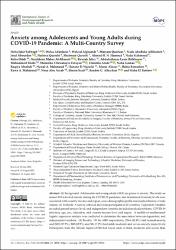Anxiety among adolescents and young adults during COVID-19 pandemic: A multi-country survey

Göster/
Erişim
info:eu-repo/semantics/openAccessAttribution 4.0 Internationalhttps://creativecommons.org/licenses/by/4.0/Tarih
2022Yazar
Sabbagh, Heba JafarAbdelaziz, Wafaa
Alghamdi, Waleed
Quritum, Maryam
AlKhateeb, Nada AbuBakr
Abourdan, Joud
Qureshi, Nafeesa
Qureshi, Shabnum
Hamoud, Ahmed H. N.
Mahmoud, Nada
Odeh, Ruba
Al-Khanati, Nuraldeen Maher
Jaber, Rawiah
Balkhoyor, Abdulrahman Loaie
Shabi, Mohammed
Folayan, Morenike Oluwatoyin
Alade, Omolola
Gomaa, Noha
Alnahdi, Raqiya
Mahmoud, Nawal A.
El Wazziki, Hanane
Alnaas, Manal
Samodien, Bahia
Mahmoud, Rawa A.
Abu Assab, Nour
Saad, Sherin
Alhachim, Sondos G.
El Tantawi, Maha
Üst veri
Tüm öğe kaydını gösterKünye
Sabbagh, H. J., Abdelaziz, W., Alghamdi, W., Quritum, M., AlKhateeb, N. A., Abourdan, J. ... El Tantawi, M. (2022). Anxiety among adolescents and young adults during COVID-19 pandemic: A multi-country survey. International Journal of Environmental Research and Public Health, 19(17), http://doi.org/10.3390/ijerph191710538Özet
(1) Background: Adolescents-and-young-adults (AYA) are prone to anxiety. This study assessed AYA's level of anxiety during the COVID-19 pandemic; and determined if anxiety levels were associated with country-income and region, socio-demographic profile and medical history of individuals. (2) Methods: A survey collected data from participants in 25 countries. Dependent-variables included general-anxiety level, and independent-variables included medical problems, COVID-19 infection, age, sex, education, and country-income-level and region. A multilevel-multinomial-logistic regression analysis was conducted to determine the association between dependent, and independent-variables. (3) Results: Of the 6989 respondents, 2964 (42.4%) had normal-anxiety, and 2621 (37.5%), 900 (12.9%) and 504 (7.2%) had mild, moderate and severe-anxiety, respectively. Participants from the African region (AFR) had lower odds of mild, moderate and severe than normal-anxiety compared to those from the Eastern-Mediterranean-region (EMR). Also, participants from lower-middle-income-countries (LMICs) had higher odds of mild and moderate than normal-anxiety compared to those from low-income-countries (LICs). Females, older-adolescents, with medical-problems, suspected-but-not-tested-for-COVID-19, and those with friends/family-infected with COVID-19 had significantly greater odds of different anxiety-levels. (4) Conclusions: One-in-five AYA had moderate to severe-anxiety during the COVID-19-pandemic. There were differences in anxiety-levels among AYAs by region and income-level, emphasizing the need for targeted public health interventions based on nationally-identified priorities.
WoS Q Kategorisi
Q1Scopus Q Kategorisi
Q1Kaynak
International Journal of Environmental Research and Public HealthCilt
19Sayı
17Koleksiyonlar
- Makale Koleksiyonu [3770]
- PubMed İndeksli Yayınlar Koleksiyonu [4223]
- Scopus İndeksli Yayınlar Koleksiyonu [6561]
- WoS İndeksli Yayınlar Koleksiyonu [6621]


















